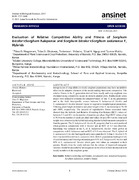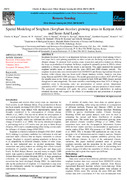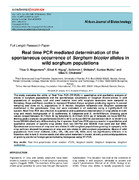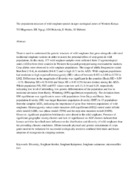Evaluation of relative competitive ability and fitness of sorghum bicolor×sorghum halepense and sorghum bicolor×Sorghum sudanense F1 hybrids
| dc.contributor.author | Magomere, Titus O. | |
| dc.contributor.author | Obukosia, Silas D. | |
| dc.contributor.author | Shibairo, Solomon I. | |
| dc.contributor.author | Ngugi, Eliud K. | |
| dc.contributor.author | Mutitu, Eunice | |
| dc.date.accessioned | 2019-04-26T17:21:26Z | |
| dc.date.available | 2019-04-26T17:21:26Z | |
| dc.date.issued | 2015 | |
| dc.identifier.issn | 1727-3048 | |
| dc.identifier.uri | http://erepository.kibu.ac.ke/handle/123456789/714 | |
| dc.description.abstract | Introgression of crop alleles in weedy sorghum populations may have an additive effect on the adaptive character of the weeds making them more competitive. The relative fitness in the F1 generation derived from weedy and crop sorghums was evaluated using competitive assays in densely planted plots. Replacement series assays were utilized to evaluate the competitiveness of the F1 in the greenhouse and in the field. Interspecific crosses between S. halepense×S. bicolor and S. sudanense×S. bicolor showed vigour in vegetative morphological parameters. Tillering, plant height at maturity and plant weight of the F1 increased up to 70, 50 and 100%, respectively. The analysis of reproductive fitness associated traits showed that the hybrids had Relative Crowding Coefficients (RCC) values of between 5.2 and 10.1 on the number of panicles per plant. High RCC values of up to 76.9 on the number of seeds per plant and values of up to 19.5 on the total seed weight were observed in the hybrid indicating that the hybrid was more competitive than the parents. The S. halepense×S. bicolor F1 progenies had less seed produced when grown in competition with S. bicolor and an RCC of 4.3 was observed. Ratooning was reduced in the F1 of S. halepense×S. bicolor when grown in competition with S. halepense and an RCC of 5.0 was observed. The F1 hybrid of S. sudanense×S. bicolor had significantly more panicles (6.3) than S. bicolor (1.9) but it was not different from S. sudanense (6.0). Both F1 populations had high levels of seed dormancy and forced germination gave 53% in S. halepense×S. bicolor and 69% in S. sudanense×S. bicolor which gave low values as compared to their parents. Results from the study indicate that the release of improved transgenic varieties should be preceded by investigation on the effect of their interaction with weedy members in the sorghum genus. | en_US |
| dc.language.iso | en | en_US |
| dc.rights | Attribution-NonCommercial-ShareAlike 3.0 United States | * |
| dc.rights.uri | http://creativecommons.org/licenses/by-nc-sa/3.0/us/ | * |
| dc.subject | Relative crowding coefficients | en_US |
| dc.subject | Sorghum bicolor | en_US |
| dc.subject | Sorghum halepense | en_US |
| dc.subject | Sorghum sudanense | en_US |
| dc.subject | Relative fitness | en_US |
| dc.title | Evaluation of relative competitive ability and fitness of sorghum bicolor×sorghum halepense and sorghum bicolor×Sorghum sudanense F1 hybrids | en_US |
| dc.type | Article | en_US |




